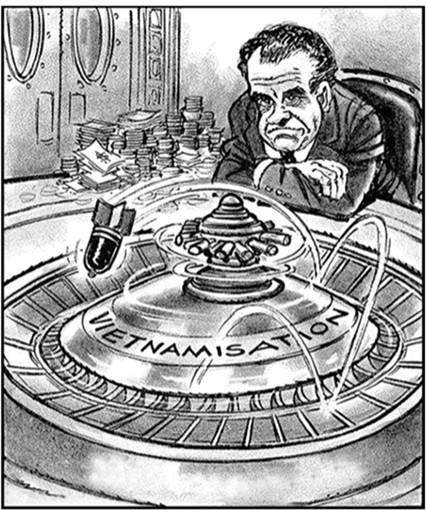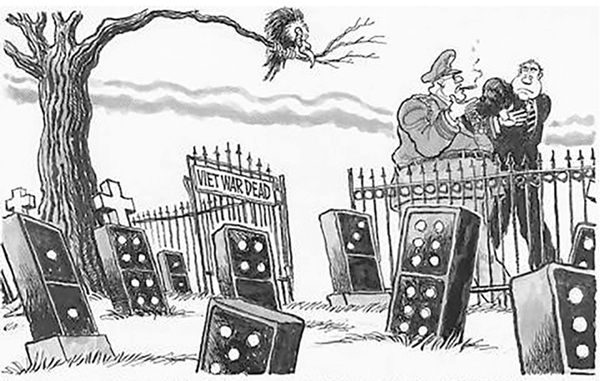|
|
|
The Wider Context in 1969The international and national scene facing Nixon when he became President in 1969 was VERY different from that facing Eisenhower when he first started propping up South Vietnam, and even Johnson when he decided to go to war in 1964. In short – as you will realise as you read on – there had not since WWII been a greater need and better opportunity for peace: 1. America no longer had world military dominance. Soviet Russia had many more conventional forces. China was now a nuclear superpower, and it was generally recognised that actually using nuclear weapons was ‘MAD’ (mutually assured destruction). 2. China and the USSR were at war. America no longer faced a united communist bloc. 3. America’s economy was in trouble. There was ‘stagflation’ (stagnant economic growth PLUS a high rate of inflation) PLUS a world oil crisis. Meanwhile: 4. The cost of the Vietnam War had become unsustainable and was preventing all other government initiatives. 5. The protest/opposition to the war was destabilising US government and society. 6. Nixon had been elected on a promise to ’bring the boys home’.
|
Going DeeperThe following links will help you widen your knowledge: Basic accounts from BBC Bitesize and Clever Lili Verdicts on Nixon - Los Angeles Times
YouTube Nixon explains Vietnamisation - 3 Nov 1969 Vietnamisation - Mr Cloke
|
Nixon's PoliciesNixon therefore embarked on the following policies: 1. Détente• Nixon wanted to be remembered in history as someone who brought peace to the United States and the world. He visited both Russia and China. • In April 1971 a US table-tennis team visited China (the so-called ‘Ping-pong diplomacy’) and in 1972 the Shanghai Communique recognised China”, and affirmed the two countries’ desire for “the relaxation of tension in Asia and the world”. • In 1972 USA and the USSR agreed the ‘Basic Principles of Relations’ Treaty and signed the SALT1 arms limitations agreement. 2. The Nixon Doctrine• On 3 November 1969 Nixon announced that, from then on, it was to be up to each country to defend itself against communism. • In terms of Vietnam, this meant a policy of ‘Vietnamisation’ – gradually pulling US forces out of Vietnam whilst building up the ARVN to resist the PAVN-VC. 3. Peace Negotiations• Henry Kissinger, Nixon’s National Security Advisor, pursued peace talks; the sticking point was that the North Vietnamese were insisting on a united Vietnam with a communist presence. |
Source A
An American cartoon published in 1972. The title of the cartoon was ‘Where it stops, nobody knows!’ |
4. The 'Madman Theory'ie the belief that, if the North Vietnamese thought he was ready to do anything (even use the nuclear bomb), he could frighten Hanoi into a negotiated agreement. Ironically, this meant that – whilst saying he wanted to end US involvement in the war – Nixon significantly escalated it: a. Operation Menu (1970) ◦ The PAVN – at the invitation of the Cambodian government – used bases in Cambodia to assemble their forces. ◦ The US had been ‘secretly’ bombing Cambodia since 1969. Then, in 1970, 100,000 US and South Vietnamese forces invaded Cambodia to attack the PAVN-VC presence in the country. The operation captured huge amounts of PAVN weapons and supplies. b. Operation Lam Son (1971) ◦ In nearby Laos, Communist forces (the ‘Pathet Lao’) were trying to take over the country, supported by the PAVN, who used Pathet Lao-controlled areas to store supplies. ◦ In 1971 the ARVN invaded Laos, supported by a massive US bombing campaign against PAVN stockpiles and the Ho Chu Minh trail. The ARVN were defeated and driven out, but the operation forestalled a VC attack. c. Operation Linebacker (1972) ◦ In March 1972, with only 10,000 US troops left in Vietnam, the PAVN launched their Easter Offensive, driving back the ARVN. ◦ Nixon ordered a massive bombing campaign (28,000 sorties April-June 1972) against the PAVN forces and supply lines, including bombing Hanoi and Haiphong, and mined North Vietnamese harbours. The Easter Offensive was defeated. |
|
Source B
An anti-war cartoon published in America in 1972 commenting
on the widening of the Vietnam War.
|
Source COur flights were secret because we were not supposed to be flying over Cambodia and Laos. Our job was to block the Ho Chi Minh Trail but we never succeeded. The whole area was devastated by our bombs but somehow the Trail was always there. The fall of Saigon was because large numbers of tanks, artillery and missiles were delivered down the indestructible Ho Chi Minh Trail. Adapted from a newspaper article by a US Air Force General. During the Vietnam War he was a pilot who flew hundreds of missions. It was published after the Americans left Vietnam.
Source DThe US bombing campaigns were intended not only to attack and weaken the enemy, they were also to show north Vietnam that the USA would not be forced out of the war and would not abandon South Vietnam. Eventually, they had their effect – in January 1973 peace talks in Paris were resumed. From Twentieth Century Depth Studies (2009).
|
5. The War At Homea. There were more than half a million US troops in Vietnam when Nixon took office. In June 1969 he announced that he was bringing home 25,000 troops. By 1970, the number of US troops in Vietnam had dropped to 334,600; to 156,800 by 1971; and to 24,200 by the beginning of 1972. b. Nixon sought to get the public onside. He: ◦ introduced in 1969 a lottery for the draft (to try to make if fairer) and in 1973 abolished it altogether; ◦ appealed to the ‘silent majority’; ◦ sponsored pro-government ‘astroturf’ groups which pretended to be speaking for ordinary people; ◦ (illegally) used the FBI’s COINTELPRO resources and the White House Special Investigations Unit to surveil and discredit anti-war activists. (He was found out in 1975 – the Watergate Scandal – and was forced to resign.) c. Nixon believed that the President should be an unquestioned dictator in matters of foreign policy, citing the powers given to President Johnson in 1964 to “take all necessary measures” to promote the security of the USA. ◦ This caused conflict with Congress, which in 1973 passed the War Powers Resolution that the President can send US forces overseas only after resolution of Congress. Nixon vetoed the Bill, but Congress forced it through.
|
Source EThose sons of bitches [the journalists who published the Pentagon papers] are killing me... We’re up against an enemy, a conspiracy. They’re using any means. We are going to use any means. Is that clear? Did they get the Brookings Institute raided last night? No. Get it done. I want it done. I want the Brookings Institute’s safe cleaned out and have it cleaned out in a way that it makes somebody else look responsible. From White House tapes recording Nixon ordering his staff to dig up information on Ellsberg and others by committing illegal break-ins.
Source FIn fact, Nixon had no intention of stopping the war at all; all he wanted to do was to make its continuance palatable to the American people... He continued to prosecute the war by financing the ARVN and bombing North Vietnam. This suited the public too; they couldn’t SEE the war coming home in a body bag – it wasn’t hurting them. From Modern World History (2009).
|
Consider:1. In what ways did Nixon change US policies in Vietnam? 2. Using the information on this page, and your wider contextual knowledge, make a list of reasons WHY American troops were whdrawn from Vietnam 1969-73. 3. Biographer Stephen Ambrose wrote about Nixon: "Everything he will be remembered for, you can take two views on ... He ended the war in Vietnam, but he kept it going for four years and took a deal that he might have been able to get in 1969." Discuss with a friend what your 'take' is on Nixon's place in the history of the Vietnam War?
|
|
|
|
|
|
Spotted an error on this page? Broken link? Anything missing? Let me know. |
|

